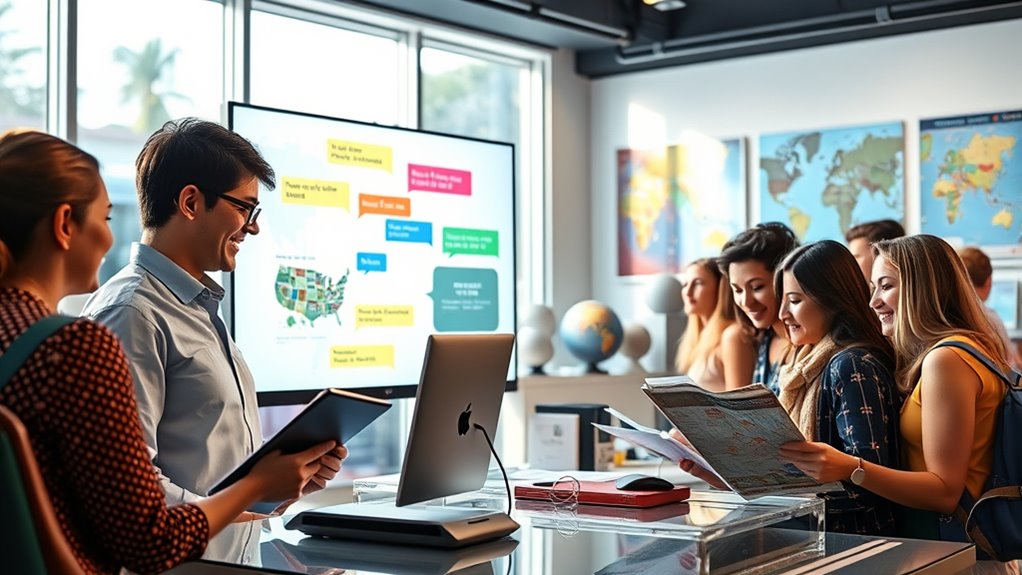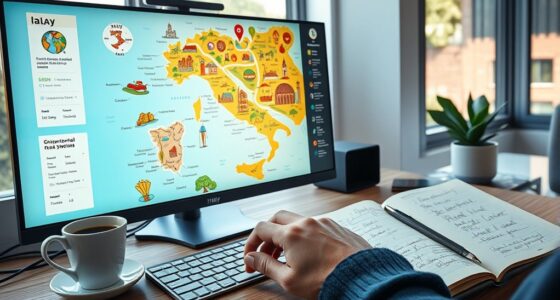Natural Language Processing (NLP) enhances your customer service in tourism by enabling instant, personalized, and multilingual interactions. It helps you understand traveler preferences quickly and offers tailored suggestions, making communication seamless. NLP-powered chatbots handle common questions anytime, reducing wait times and boosting satisfaction. It also analyzes feedback and sentiment to improve services proactively. If you keep exploring, you’ll discover even more ways NLP can transform travel experiences for your visitors.
Key Takeaways
- NLP enables personalized travel recommendations by analyzing customer messages and preferences in real-time.
- It supports multilingual communication, making services accessible to travelers worldwide.
- Sentiment analysis helps identify customer emotions and feedback to improve service quality proactively.
- Chatbots powered by NLP provide instant, round-the-clock assistance for bookings and inquiries.
- NLP detects customer traits and preferences, allowing tailored, empathetic interactions that foster loyalty.

Have you ever wondered how travelers find personalized recommendations or how tourism companies improve their services? Natural Language Processing, or NLP, plays a significant role in transforming customer interactions by making communication more seamless and tailored. When you reach out to a travel agency or use a tourism app, NLP-powered systems analyze your messages and preferences instantly, helping companies deliver better, more relevant responses. One of the key features driving this improvement is multilingual support. Since travelers come from all over the world, NLP enables systems to understand and respond in multiple languages accurately. This not only broadens accessibility but also creates a more inclusive experience. Whether you’re speaking in English, Spanish, Mandarin, or any other language, NLP tools can interpret your input and generate appropriate replies, removing language barriers that once limited personalized service.
NLP enables multilingual support, making travel services more accessible and personalized worldwide.
Another crucial aspect of NLP’s contribution to customer service in tourism is sentiment analysis. This technology scans reviews, social media comments, and customer feedback to determine how travelers feel about their experiences. Sentiment analysis helps tourism providers gauge overall satisfaction levels and identify specific areas for improvement. For example, if many customers express frustration over long wait times or confusing signage, the company can quickly address these issues. By understanding emotional cues in customer communications, businesses can proactively enhance their services, making travelers feel heard and valued.
Furthermore, NLP makes interactions faster and more efficient. Instead of waiting for human agents to become available, chatbots powered by NLP can handle common questions around the clock, providing instant responses. These bots can assist with booking inquiries, travel itineraries, or local recommendations, reducing wait times and improving overall satisfaction. Because they process language contextually, these systems understand complex queries and offer nuanced answers, creating a conversational experience that feels natural and helpful.
Additionally, NLP can help identify traits of customer preferences and adapt interactions accordingly, allowing tourism providers to tailor their services even more precisely to individual needs. As you engage with tourism services, NLP works behind the scenes to interpret your needs, regardless of the language you speak or the emotions you express. By integrating multilingual support and sentiment analysis, tourism companies can deliver more personalized, responsive, and empathetic service. This not only elevates your travel experience but also fosters loyalty and trust. In practice, NLP bridges the gap between travelers and providers, making every interaction smoother, more meaningful, and truly tailored to your preferences.
Frequently Asked Questions
How Does NLP Handle Multilingual Customer Inquiries?
When you receive multilingual customer inquiries, NLP handles them by performing multilingual translation, allowing seamless understanding across languages. It recognizes cultural nuances, ensuring responses are appropriate and respectful. NLP models analyze the language context, translating and interpreting inquiries accurately, so you can provide personalized, efficient support. This technology bridges language gaps, making customers feel valued and understood, ultimately enhancing their experience and satisfaction in the tourism industry.
Can NLP Analyze Emotional Tone in Customer Messages?
Yes, NLP can analyze emotional tone in customer messages through emotion detection and sentiment analysis. You can identify whether your customers feel happy, frustrated, or confused by analyzing their language patterns. This allows you to respond more empathetically and tailor your customer service approach. By understanding emotional cues, NLP helps you improve communication, boost satisfaction, and build stronger relationships with your travelers.
What Are the Privacy Concerns With NLP Data Collection?
You might worry about data security, but using anonymization techniques helps safeguard your customers’ privacy. While NLP collects valuable insights, it can also raise concerns about personal information exposure. To address this, implementing strict data security measures and anonymization ensures that sensitive data stays confidential. This way, you can benefit from NLP’s capabilities without compromising your customers’ trust or risking privacy breaches.
How Quickly Can NLP Systems Respond to Customer Queries?
You’ll find that NLP systems respond to customer queries in real time, often within seconds. Thanks to advanced algorithms and optimized response speed, these systems process language quickly, enabling instant interactions. This real-time processing guarantees you get prompt support, whether booking a trip or solving a concern, enhancing your overall experience. As a result, customer service becomes more efficient and satisfying, making your travel planning smoother and more enjoyable.
What Are the Cost Implications of Implementing NLP in Tourism?
Think of implementing NLP as planting a garden; initial costs for technology and training are like planting seeds, but over time, you reap cost savings through automation and efficiency. While there are implementation challenges, such as integrating systems and managing data, the long-term benefits often outweigh these hurdles. You’ll find that investing in NLP can reduce operational costs, improve customer satisfaction, and create a flourishing, streamlined tourism experience.
Conclusion
By embracing Natural Language Processing, you enhance communication, improve efficiency, and personalize experiences. You streamline inquiries, respond faster, and understand customer needs better. You reduce misunderstandings, increase satisfaction, and build loyalty. You leverage technology to connect more deeply, serve more effectively, and stand out in the tourism industry. With NLP, you transform customer service into a seamless, engaging, and memorable journey—making every interaction count and every traveler feel valued.









